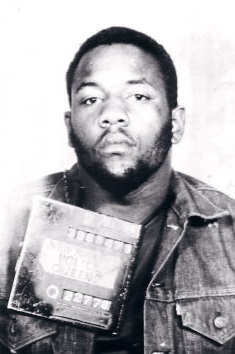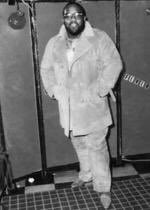by Ran

Lorenzo Nichols was born on December 25, 1958, in Birmingham, Alabama. He was raised by his grandmother in Bessemer, AL until he moved in with his mother, Louise Coleman, in Queens, New York at the age of 10. Nichols and his mother, a nurse's aide (his father was a plumber), lived in the Ozone Park neighborhood, located in the southeast section of the borough.
Nichols dropped out of middle school. He began his criminal career committing armed robberies. His first arrest came at 13-years-old and he was arrested again in 1976. Nichols eventually moved on to selling cocaine and heroin, supplied by Italian Mafiosi. He later obtained his heroin from a Chinese supplier whom Nichols' associates referred to as "John" after finding his real name difficult to pronounce.
The bulk of Nichols' organization's profits stemmed from hand-to-hand sales of $10 and $25 amounts of narcotics. Working 15-hour shifts was common practice for street dealers under his employ.
While incarcerated in a New York state prison, Nichols met Howard "Pappy" Mason, who, after initially serving as one of the former's security guards upon the pair's release, eventually formed his own cocaine trafficking gang. Nichols would routinely supply Mason's organization, the Bebos, with product.
In 1982, Nichols' older sister, Viola, went to work for her brother, processing cocaine into crack. Viola was paid approximately $3,500 per week to cook 250 grams of powdered cocaine into 10,000 vials worth of crack for the Bebos. She would eventually develop a destructive drug habit.
Nichols controlled drug sales on Jamaica's 150th Street.
In 1985, Nichols was arrested following a raid on his mother's apartment which resulted in weapons and narcotics charges. Following his conviction, he was sentenced to 25 years to life in state prison. That same year, Nichols' parole officer, Brian Rooney, was shot to death. Nichols' who gave the order to have Rooney assaulted but, according to him, not killed, was subsequently charged with second-degree murder. Rooney became a target of Nichols' because he had him sent back to prison for a parole violation.
While Nichols was incarcerated, he gave the order to have rival drug trafficker Isaac Bolden murdered. Bolden, who'd robbed members of Nichols' organization, was killed in November of 1986. In 1987, Nichols was indicted and charged with second-degree murder in connection to Rooney's killing.
In May of 1987, Nichols' wife, JoAnne, was kidnapped and held until a $77,000 ransom was paid for her release. Initially, the kidnappers demanded a ransom of 10 kilograms of cocaine. After two days as a captive, JoAnne, who had been taken from the Elmont, Long Island home she shared with Nichols, was set free.
In December, 19-year-old Bebos-associate Todd Scott shot a woman, whom he'd suspected of stealing some of his cash and drugs, in the chest on 157th Street in Queens.
In late December of 1987, the mother of Nichols' son, 20-year-old Myrtle Horsham, was shot to death in a car in Jamaica, Queens. Nichols, who was incarcerated at the time, later testified that he'd ordered the murder because he'd discovered that Horsham had stolen some of his cash and had subsequently spent it on another man. Horsham had blamed the missing money on a robbery. Nichols had given the assignment to kill Horsham to one of his enforcers, Brian "Glaze" Gibbs, whom he'd recruited after the latter was acquitted of murder than June. Gibbs delegated the job to two of his subordinates. The two triggermen, who'd been surveilling Horsham, waited until she left her mother's Springfield Gardens home and got into another woman's vehicle with her son and then rushed into the back seat of the car themselves. The pair then forced Horsham's friend to drive to a dead-end street at gunpoint. Ignoring Horsham's pleas for her life and her offer to pay them $100,000 to walk away, they shot both women. The gunmen then placed the 3-year-old in Gibbs' car, who'd been supervising the entire incident. Gibbs in turn drove back to Horsham's mother's residence, left her grandson on the front lawn and called from a payphone to tell her where he could be found. While Horsham succumbed to her headshot, the other woman's injuries proved to be non-fatal.
That same month, Gibbs orchestrated the shooting death of Maurice Bellamy at Nichols' behest. The triggerman, sent by Gibbs, shot Bellamy in the head at the Linden Ave. Laundromat, where the latter worked. Maurice was targeted because Perry Bellamy, Maurice's son, had cooperated with investigators probing Rooney's murder. Perry himself, a member of Nichols' organization, was out of reach as he'd been given protection by law enforcement. Following the shooting, Nichols called Bellamy's home and told his relatives that he wasn't responsible for the killing. The murder was intended to lure Perry out of hiding in order to attend the funeral. The plan was abandoned when Perry was escorted, chained, to the funeral by police. He is still incarcerated following a state murder conviction stemming from his time as a member of the organization.

Nichols was convicted of weapons and narcotics charges in January of 1988.
At about 3:30 a.m. on February 26, 22-year-old Officer Edward Byrne, of Jamaica's 103rd Police Precinct, was fatally shot five times in the head as he guarded the home of a witness from his patrol car on South Jamaica, Queens' Inwood Street. Todd Scott, serving as a decoy, distracted Byrne by getting his attention while standing on the passenger side of the police vehicle. The triggerman, David McClary, positioned on the driver's side, shot Byrne at close range using a nickel-plated revolver. Scott, McClary and Scott Cobb, the getaway driver, then fled the scene in a yellow Dodge. Mason, who was incarcerated at the time for his role in the murder of his parole officer, had sent a message through Phillip "Marshal" Copeland that a police officer should be murdered. Copeland, Scott, McClary and Cobb split the $8,000 payment for the killing. Each member of the foursome was apprehended during the first week of March. Cobb, who'd subsequently made a videotaped confession, was eventually given a sentence of 25-to-life alongside the other three.
On May 12, Richard Frejomil of Brooklyn was convicted in connection with JoAnne Nichol's kidnapping.
On May 21, Nichols' South Jamaica residence was firebombed, resulting in the death of his 50-year-old sister, Mary Nichols. A perpetrator fired 16 rounds from a semi-automatic weapon at the front of the three story home a little after 12:30 a.m. He then proceeded to throw a bomb through one of the ground-floor windows before fleeing in a gray Buick sedan with three accomplices who'd remained in the car. Mary, who was wheelchair-bound as a result of a stroke years earlier, was discovered by firefighters in a bedroom on the second floor of the house. Her 10-year-old son, Wynell Nichols, was transported to Jamaica Hospital before being taken to New York Hospital for treatment of second and third-degree burns on his face and both arms. Mary's daughters, Tamika Nichols and Ida Nichols, fled the house unharmed. Nichols' 70-year-old mother, Louise Coleman, and his stepfather, Amos Coleman, also escaped without injury after unsuccessfully attempting to pull Mary to safety. At the time of the fire, Nichols was incarcerated at the Shawangunk Correctional Facility located near Kingston, NY.
On August 11, 1988, a federal taskforce comprised of 400 agents conducted raids on homes in three states in the most wide-ranging response to Officer Byrnes' murder six months prior. Louise Coleman, who was accused of making drug sales, and Amos Coleman were arrested in Birmingham; JoAnne Nichols was arrested in Norfolk, Virginia. Mason's mother, Claudia Mason, was arrested as well. Nichols himself was arrested in his cell at the Wallkill Correctional Facility; Mason was also arrested while serving time in upstate New York. Five buildings, including Louise Coleman's home, loaded machine guns, cash, heroin and cocaine were all seized during the sweep.
Gibbs, who was also arrested on August 11, was apprehended on drug trafficking charges by federal agents at a McDonald's restaurant in South Carolina. Seeking leniency, Gibbs agreed to cooperate against Nichols. Though he pleaded guilty to five murders and two attempted murders, he served less than 10 years in prison. Gibbs did his time at the federal facility located in Otisville, NY and FCI Sandstone, a low-security prison in Minnesota.
Following Viola Nichols' arrest, she eventually pleaded guilty as part of a deal with prosecutors that required her to cooperate against her brother. She was entered into the federal Witness Protection Program for her safety. In July of 1989, Viola testified in open court against Claudia Mason and Bebos third-in-command Char "Shocker" Davis, both charged with conspiracy to distribute cocaine base. (10) As a consequence, Davis was convicted and subsequently sentenced to 33 years in federal prison by Judge Edward Korman in 1990.
On September 28, 1989, Nichols pleaded guilty to two counts of racketeering-related murder in connection to the deaths of Bolden and Horsham. As part of a plea agreement with federal prosecutors, Nichols gave testimony explaining his role in the killings in the chambers of Federal District Court Judge Edward R. Korman. The agreement also required that he cooperate against members of his organization, including Mason. Nichols was already serving a 25-year-to-life sentence stemming from drug convictions in state court.
In 1992, Nichols pleaded guilty to ordering Rooney's murder and was sentenced to a term of 25 years to life in prison for his role in the crime. He was also given a 40-year sentence in connection with federal racketeering, murder and narcotics convictions.
Following his July 1997 release from prison, Gibbs entered the witness protection program and now lives under an assumed name in the Southern U.S. He makes nearly $100,000 per year.
At its peak, Nichols' organization generated $20 million annually in drug sales.
A two-year criminal investigation, nicknamed Operation Road Runner, exposed both Nichols' and convicted Detroit drug trafficker Richard "White Boy Rick" Wershe's involvement in an auto theft ring, which sold over 250 Florida vehicles to 14 other states from 1999 - 2005, grossing $8 million in the process. Nichols pleaded guilty to racketeering for his role in the scheme in December of 2006. Nichols, who, along with Wershe, was incarcerated in Florida and in the witness protection program, received a 10-year sentence after confessing to heading the ring.
In March of 2010, Nichols became eligible for parole. However, he declined to appear before the board. He is currently incarcerated at the Clinton Correctional Facility, a maximum-security prison located in Dannemora, NY.

Nichols (far left) and Kenneth "Supreme" McGriff (far right)
Brian "Glaze" Gibbs and Lorenzo "Fat Cat" Nichols




1 comment:
The most feared gangster in new York never ,u had guys in the mob that make him look like a alter boy ,he ain't even top ten ,just cause he was stupid enough to kill or have his parole officer killed ,don't make him the most feared,it's the real gangsters killing and getting away with murders that are dangerous
Post a Comment